Michelangelo & Sebastiano
15th March – 25th June 2017
National Gallery, London
When it was announced that the National Gallery was putting on an exhibition to combine the titan Michelangelo with the lesser-known artist Sebastiano del Piombo, I was worried that there would be an imbalance. Although del Piombo is undoubtedly one of the most important painters of the first half of the 1500s, he not recognised in the same way as Michelangelo – a man whose name is synonymous with the Italian High Renaissance – and unless you have studied art history it is unlikely that his name will be familiar. But in truth, Michelangelo is often misunderstood, and solely associated with his sculpture David or his Sistine Chapel frescoes. Both artists deserve fresh eyes, for us all to forget preconceived ideas and re-assess them both.
Michelangelo Buonarroti (1475-1564) met Sebastiano Luciani (nicknamed del Piombo) (1485-1547) in Rome in 1511. The elder artist was just finishing his masterpiece on the Sistine Chapel ceiling, at the peak of his game. His career had grown from the workshop of Ghirlandaio, through patronage of the Medici family and culminating for working for the Pope. For Michelangelo, being an artist was as much a pursuit of the mind as it was one of the physical practice of drawing, painting or sculpting. He was a true Renaissance man; a humanist thinker, a poet, architect and engineer. He obsessively studied human anatomy and dissected corpses in order to further his scientific understanding so that he could depict the body with complete confidence. And this knowledge is visible in drawings such as this, Study for the Raising of Lazarus (1516), where the lines are made with conviction. There is a brilliant energy in Lazarus’ movement, both a weight and lightness that make him at once monumental and elegant.
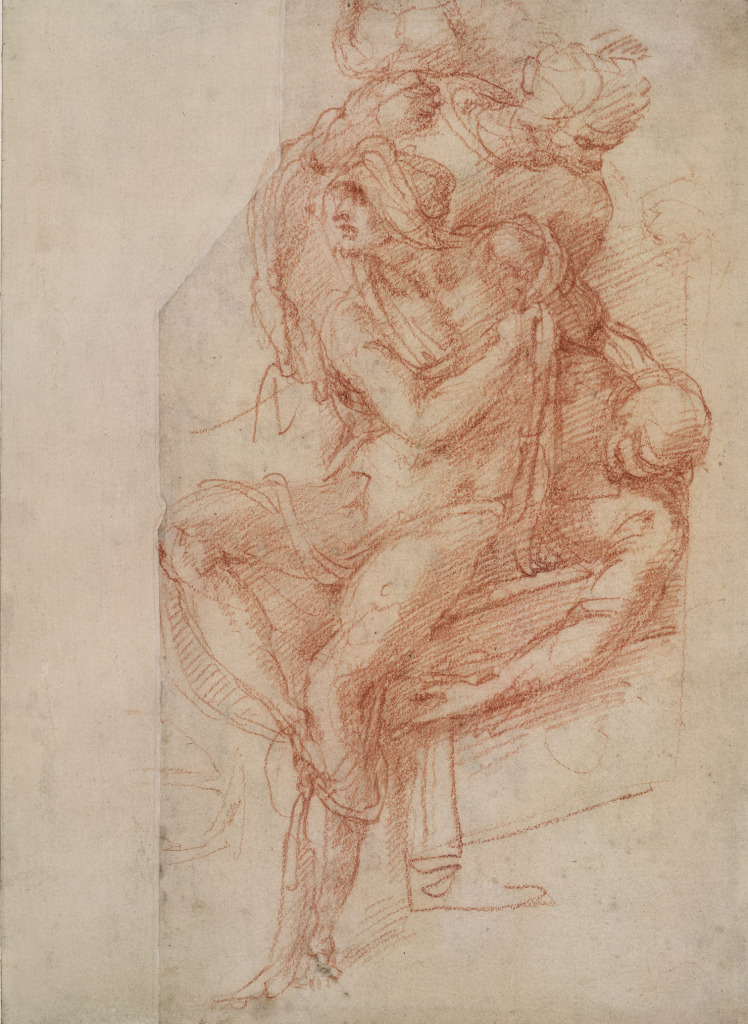
Study for the Raising of Lazarus (1516) by Michelangelo Buonarotti, red chalk on paper, © The Trustees of the British Museum
Sebastiano del Piombo was probably trained by Giorgione, but his artistic development shows that he absorbed the lessons colouring from the the Venetian masters, sharp draughtsmanship from Albrecht Dürer and the elegance from Raphael, Michelangelo’s main rival. But to say that Sebastiano was just an imitator of others is not fair. His style was a culmination of his artistic education paired with a creative intelligence that allowed him to create works of powerful impact as well as delicate sensitivity. The Raising of Lazarus (1517-19) depicts a miraculous moment from the Bible, when Christ commanded ,”Lazarus come forth”, and Lazarus awoke from death as if from sleep. Del Piombo captures the height of the drama with spectacular imagination. The composition is ambitious and the scale enormous – without the vast frame the painting is around 3.8m x 2.8m. In addition to Christ and Lazarus there are over 30 other figures in the scene, each individual and reacting in their own way to the action before us. It recalls Giotto‘s masterpiece of the same subject in the Scrovegni Chapel, reflects the influence of Venetian painting in the jewel-like colours, and shows classicism in the backdrop and the idealised faces in the crowd. And yes, Lazarus is a carbon-copy of Michelangelo’s design, but the vivacity and dynamism of the work is entirely del Piombo’s own.
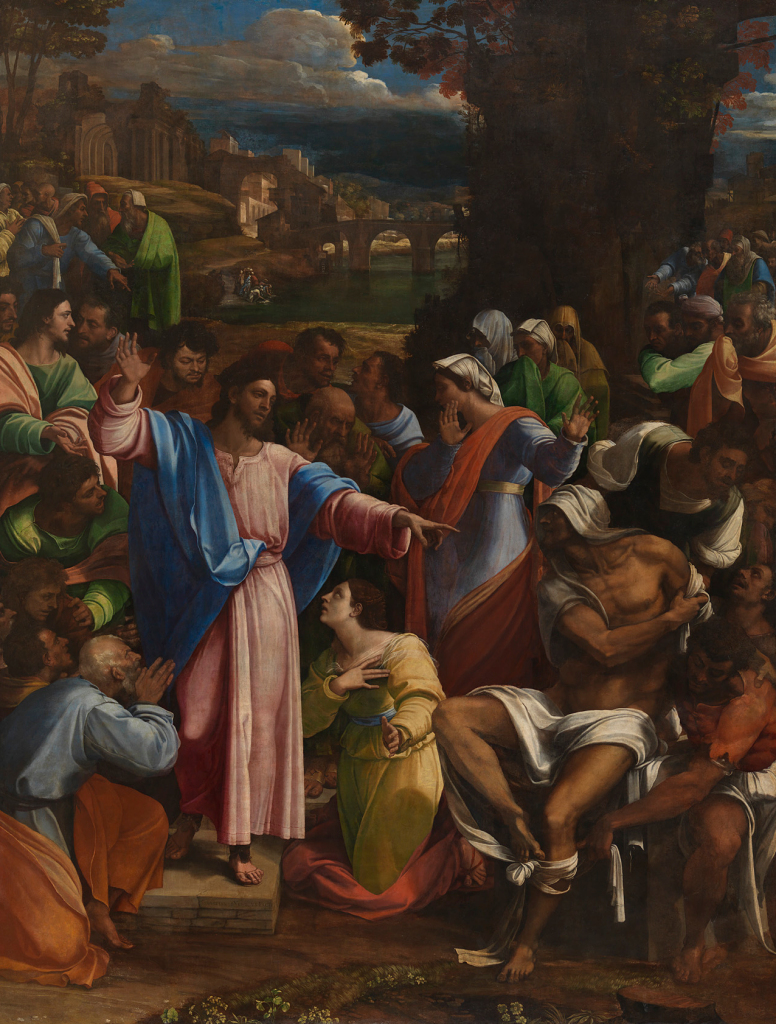
The Raising of Lazarus (c.1517-19) by Sebastiano del Piombo, oil on canvas, transferred from wood, © The National Gallery, London
It was wonderful to see the Taddei Tondo (c.1504-5) included in the exhibition, the only marble sculpture by Michelangelo in the UK, which has only been loaned once since it was bequeathed to the RA in 1829. Being unfinished (it wasn’t unknown for Michelangelo to abandon projects due to lack of money or interest) it gives us an opportunity to see how he worked. The roughly textured surfaces demonstrate his tooling process and the rhythm with which he worked. Put in the context of this exhibition, it allows us to make sense of the composition, and see how both artists tackled the subject matter. In del Piombo’s The Virgin and Child with Saint Joseph, Saint John the Baptist and a Donor (1517) there are obvious parallels in the infant Christ, precariously outstretched on the lap of his distracted Mother. Mary is not the cooing maternal-type we see in other works from the time – I am thinking of Raphael’s Alba Madonna (c.1510) also in the National Gallery – but rather a monumental, serene and solid presence with a responsibility as Mother to all.
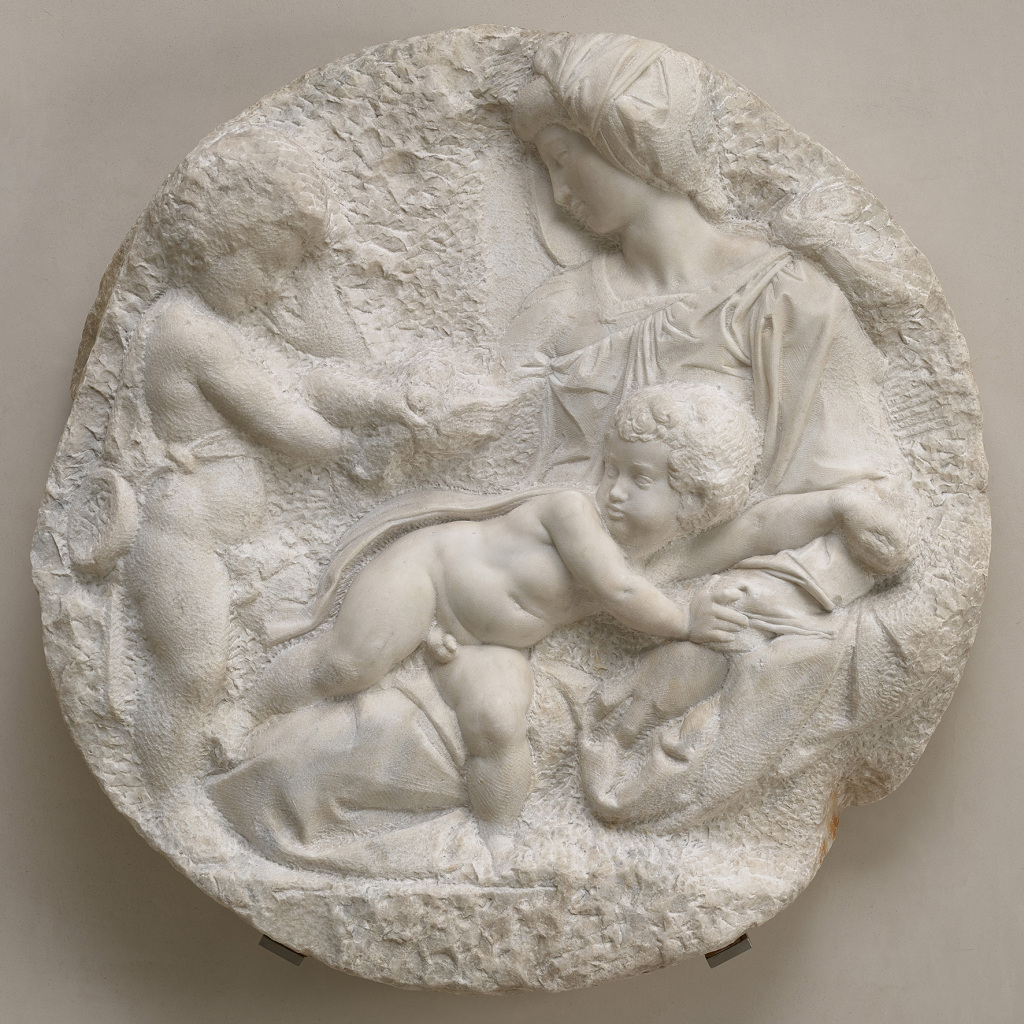
The Virgin and Child with the Infant Saint John the Baptist (‘The Taddei Tondo’) (c.1504-1505) by Michelangelo Buonarotti, marble, © Royal Academy of Arts, London; Photographer: Prudence Cuming Associates Limited
There is elongation of form in both the sculpture and the painting, hinting at the stylistic move from High Renaissance to what will be Mannerism. Particularly visible in the painting below in Mary’s long fingers and the body of Jesus, which is more like that of an older child than a baby. Michelangelo applies the same exaggerated scale, something that will inspire the later rather warped figures in Parmigianino‘s work (notably The Madonna with the Long Neck from 1534-40).
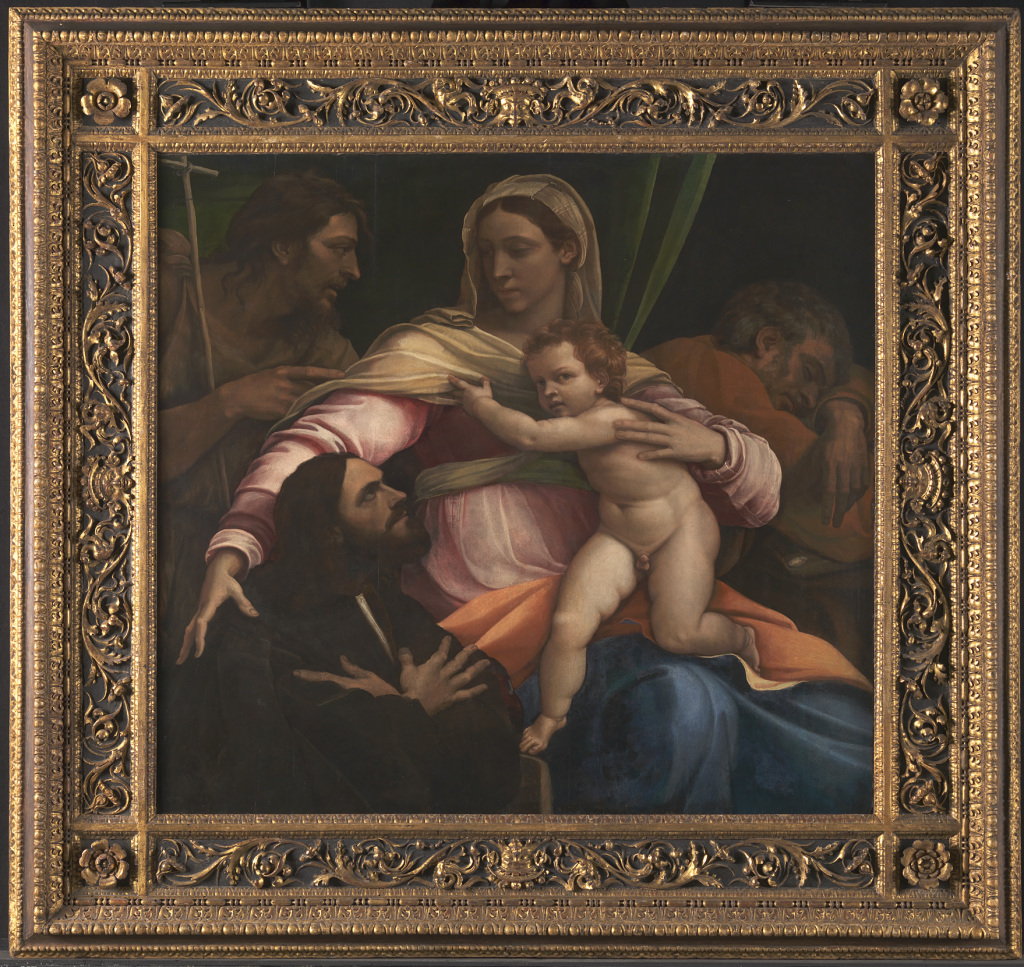
The Virgin and Child with Saint Joseph, Saint John the Baptist and a Donor (1517) by Sebastiano del Piombo, oil on wood, © The National Gallery, London
The visual narrative provided by the drawings, paintings and sculptures in the exhibition is reinforced by written correspondence between the artist’s. Seeing their handwriting in the chains of letters really gave a unique view into their lives. One particular exchange of letters following the death of Raphael is amusing in the business-like tone of who should continue the decoration of the Papal appartments, in which del Piombo wants Michelangelo to ‘recommend me to the most reverend Monsignor’, Cardinal Giulio de’Medici. Another fantastic addition to the displays was a recreation of the Borgherini Chapel (1516-24) by Sebastiano del Piombo in San Pietro in Montorio, Rome. The main Flagellation scene is another of Michelangelo’s designs, but the colouring and emotion that come from Sebastiano’s that moves away from the sculptural quality of the drawings near by.
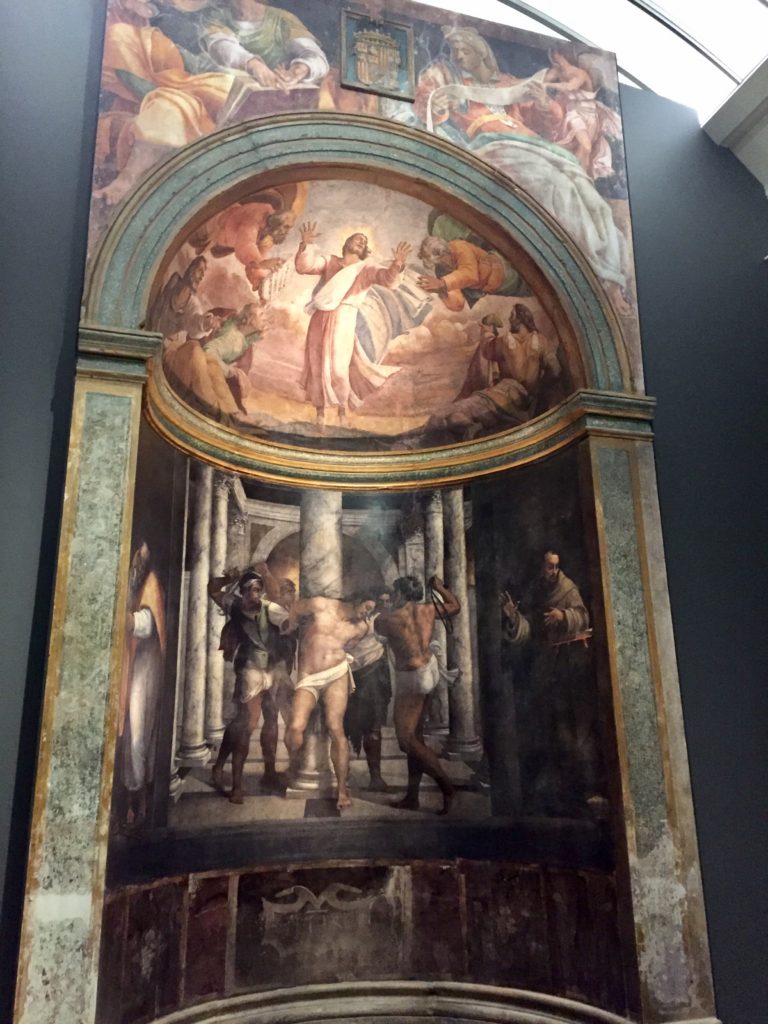
Recreation of the Borgherini Chapel (1516-24) by Sebastiano del Piombo, mural in oil, San Pietro in Montorio, Rome, taken inside the exhibition
The remarkable friendship shared by Michelangelo and Sebastiano was one that had a significant impact on art history. I think the usual tempestuous nature of artists (which Michelangelo was renown for) means that this is a rare thing, especially historically when there was fierce competition for commissions and technical secrets were closely guarded. One can only imagine the meeting of these two artistic talents. Presumably Sebastiano was in awe of Michelangelo, and the elder impressed with the younger artist’s talent. In one of the letters Sebastiano addresses Michelangelo as ‘Dearest friend, dearer to me than a father’, showing a relationship that was both professionally and personally important, although somewhat stoic Michelangelo rarely seems to fully let his guard down. Rome was a particularly competitive fighting ground for artists, as both the Catholic Church and monied noblemen demanded the best art, which makes this relationship even more unusual. While the exhibition is filled with a staggering selection of works by both artists, it is their connection which makes it so fantastic. And far from being unbalanced, Michelangelo’s reputation is justified and del Piombo’s significance is underscored.
